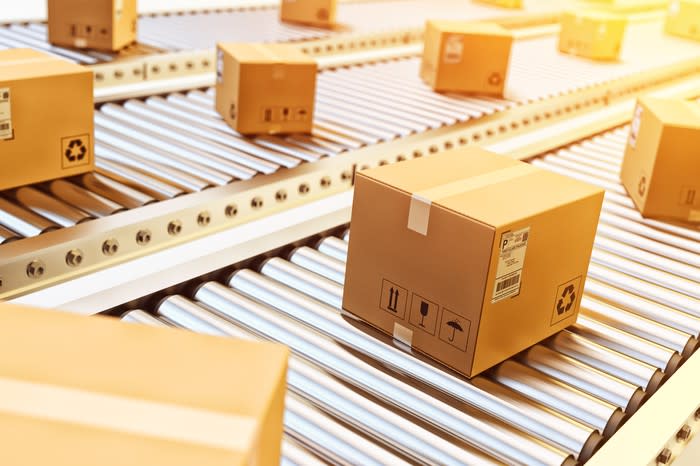The 1 Key Number You Should Focus On at UPS
Sometimes the media attention distracts from the key determinant of a stock's earnings. That's arguably the case with United Parcel Service (NYSE: UPS) and FedEx (NYSE: FDX) right now. While the so-called Amazon.com (NASDAQ: AMZN) threat attracts attention, the reality is that there's more than enough growth in e-commerce to go around -- and the key to prospects at UPS and FedEx isn't so much e-commerce volume growth, it's ensuring profitable e-commerce delivery growth. In this line of thought let's take a look at UPS' recent earnings and the key figure investors should be gleaning from it.
Package delivery is more than just Amazon
A quick look a chart of e-commerce growth in the U.S. shows it continues to grow at a mid-teens rate, but still only represents around 10% of retail sales. In other words, the trend remains strong, and it looks like there is a long way to run. Amazon is obviously going to be a big part of that, but it's probably not as important to FedEx and UPS as is often understood.

Image source: Getty Images.
For example, until recently Amazon only represented around 1.3% of FedEx's total revenue and around 3% for UPS. However, it's highly likely that Amazon deliveries are/were a relatively low-margin activity for UPS/FedEx. After all, FedEx didn't decline to renew its contract to make express and ground deliveries for Amazon without a good reason.
Instead, FedEx has taken a conscious decision to focus on broader e-commerce deliveries. Meanwhile, UPS' transformation strategy (outlined in September 2018) sees it refocusing on four growth areas:
Small and medium-sized business
Healthcare and life sciences
International high-growth areas
Global business-to-consumer (B2C) and business-to-business (B2B) e-commerce
Simply put, there's a big world of deliveries out there, and it's not just Amazon. The key challenge and opportunity for FedEx and UPS is actually growing volume and margin with e-commerce deliveries.
US Change in E-Commerce Sales data by YCharts
UPS turns the corner
As you can see below, the key U.S. domestic package segment has grown revenue in recent years, but margins have declined; leading to falls in operating income.
UPS U.S. Domestic Package Growth | 2015 | 2016 | 2017 | 2018 |
|---|---|---|---|---|
Revenue growth | 2.5% | 4.2% | 6.5% | 6.9% |
Operating Income growth | 4.3% | 4.5% | (7.5%) | (15.3%) |
Data source: UPS presentations. Analysis by author. Reported figures.
Clearly, UPS needed to take action, and management's transformational plan involves a substantial ramp-up in expenditures in order to expand and modernize (plans include extensive automation technological deployment) its hubs so it can create a more cost-efficient network. In this way, UPS can fully benefit from the extra scale coming from volume growth. The good news is there's evidence of it coming to fruition.
First, as you can see in the chart below, volume increased significantly in the second quarter, and revenue per piece held up well, leading to a 7.7% increase in U.S domestic package revenue in the second quarter, while the segment's operating income increased a whopping 28.6%.

Data source: UPS presentations. Chart by author.
However, the real margin improvement story isn't so much about improving revenue per piece or even volumes as it is with reducing the unit cost per piece delivered. In other words, UPS' investments are starting to help cut costs, which is, in turn, helping margin.
The total cost per piece rose just 0.5% in the second quarter, and revenue per package also rose 0.5%, meaning the increase in volume is dropping into the bottom line.
UPS U.S. Domestic Package | 2017 | 2018 | Q1 2019 | Q2 2019 |
|---|---|---|---|---|
Total cost per piece growth | 5.5% | 6.6% | 2.8% | 0.5% |
Data source: UPS presentations
Moreover, outgoing CFO Richard Peretz called for future "improvement in operating margin for the US business" with "cost per piece coming down and all that comes together in what we guided for '19 and when we get to '20." In other words, UPS is set to continue increasing margin due to improvements in its network's efficiency.
Too early to be triumphant
All told, investors should stop worrying too much about Amazon and focus on what UPS is doing to improve the margin of e-commerce deliveries. It's early days yet, and UPS still needs to go through the important peak delivery period -- where its upgraded network will be tested out -- before investors can fully accept CEO David Abney's assertion, given on the earnings call, that UPS has passed "an important turning point."
Nevertheless, the early evidence is good and a cause for optimism for the rest of the year -- just keep an eye out for the cost per piece.
John Mackey, CEO of Whole Foods Market, an Amazon subsidiary, is a member of The Motley Fool's board of directors. Lee Samaha has no position in any of the stocks mentioned. The Motley Fool owns shares of and recommends Amazon and FedEx. The Motley Fool has a disclosure policy.
This article was originally published on Fool.com

 Yahoo Finance
Yahoo Finance 